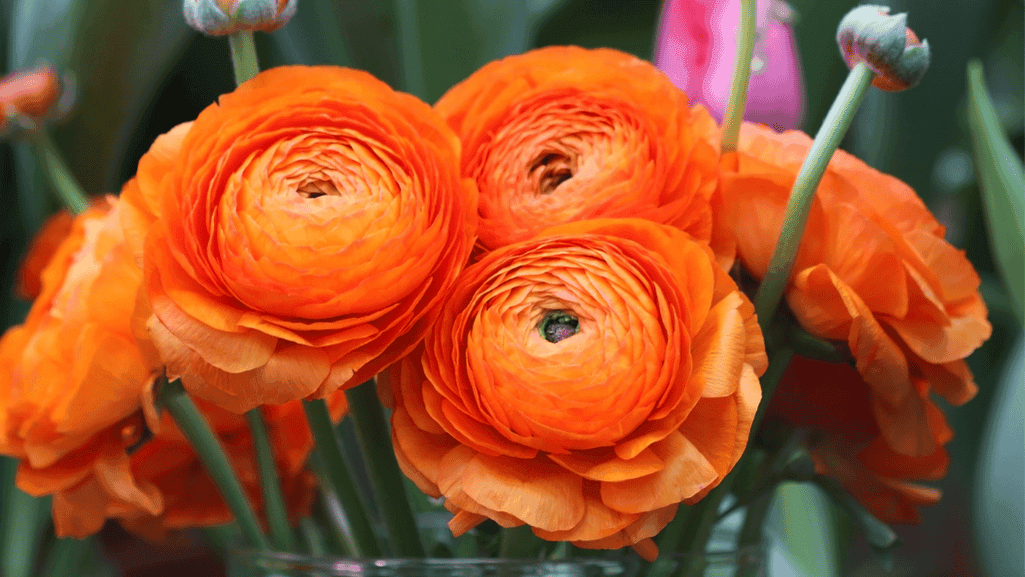
Beautiful flowers gardenia Plants For Your homes

Ranunculus Flowers are standout cut flowers known for lush, rose-like layers and a stunning range of colors from cream to deep burgundy. These bulbs, or claw-shaped corms, reward gardeners with abundant stems when planted correctly and given cool conditions and full sun.
Planting timing varies by USDA zone: fall in zones 8–10 for late winter to early spring display, and late winter to very early spring in zones 4–7 for early summer color. Use well-drained soil and avoid soggy spots to prevent rot; larger corms usually give stronger plants and more blooms.
This guide explains corm prep, spacing, container tips, and the ideal harvest stage—the soft “marshmallow” bud—for a roughly 10-day vase life. Expect about 90 days to first blooms and a 4–6 week flowering window when care and light are right. Maintain airflow and water at soil level to reduce disease and protect foliage.
Ranunculus asiaticus and modern hybrids are prized for their layered, rose-like petals and sturdy stems. These 4–5 inch blooms make excellent cut stems for arrangements and last when harvested at the right stage.
They are sold as corms, not true bulbs. Corms store energy to push strong early growth and prolific blooms.
Colors span whites and creams to apricot, pink, orange, red, and deep burgundy. Quality ranunculus corms set you up for bigger heads and longer stems.
Learn how to grow ranunculus and extend vase life in the next section.
Timing your planting to local climate is the single best move for reliable spring blooms. Plan around your usual spring weather and frost history so corms establish in cool, steady conditions.
In warm coastal and southern zones, corms are best planted fall. This captures cool soil and delivers late winter to early spring bloom time.
Planted fall beds often open earlier and can extend the display when nights stay mild. Consider low tunnels to protect against unexpected cold snaps.
For colder zones, wait until late winter or very early spring so roots form before rapid warming. Pre-sprout corms about four weeks before your last frost and plant once soil is workable.
These plants are short-day sensitive; longer days and heat speed opening. Space at least two successions 10–14 days apart to extend the cutting window and avoid compressed bloom time.
For regional tips, see growing ranunculus in a cold climate.
A short prep routine with soaking and pre-sprouting gives corms a reliable head start. Begin by sorting on arrival and discard any that are soft or moldy.
Rehydrate healthy corms by soaking them in cool water for 3–4 hours. Change the water with a light trickle to keep oxygen levels up and avoid stagnation.
After soaking, place corms on about 1″ of moist mix, cover with ~1″ more, and hold in the dark at 50–60°F for about 10 days. Look for short white roots before planting.
Plant claws down, roughly 2 inches deep and 5–8 inches apart in beds. Use light, well-drained soil amended with grit when needed to prevent rot.
For pots, choose a soil-less mix with excellent drainage. Space by pot size: one per 8″, two per 12″, and three per 18″ to avoid crowding in ranunculus pots.
Water in gently at soil level to settle the medium. Label planting dates and varieties, and watch forecasts—protect young growth if a late frost threatens.
Managing sun, water, and temperature makes the difference between average and premium stems. These plants thrive with bright light and cool weather. Aim for full sun while keeping daytime temps below about 70°F when possible. Deploy shade cloth during heat spells to lengthen stems and protect closed centers.
Full sun is ideal, but use shade cloth on long, hot days. A light-filtering cloth keeps temperatures down and preserves bud quality. In hot areas, give morning sun and afternoon shade or use taller companions to cast partial shade.
Install drip irrigation and water early to keep foliage dry. Good spacing and removing lower leaves improve airflow. These steps cut powdery mildew risk on dense foliage.
They are heavy feeders: pair nitrogen for robust foliage with phosphorus-rich feeds to push buds. Organic fish/seaweed emulsions and a touch of blood meal work well as balanced food.
Short stems often mean heat stress or too little shade. Open centers signal long days and high temperature. Stalled buds usually point to nutrient or root problems—check soil and adjust feed.
Cut at the soft “marshmallow” stage—when the primary bud shows color and yields slightly to gentle pressure. This timing gives about a 10-day vase life and encourages more blooms to open later.
Cut stems deep for longer follow-up stems and immediately remove any leaves that would sit below the waterline. Place trimmed stems in clean, cool water and condition them in low light to hydrate slowly and evenly.
Expect roughly 4–6 weeks of peak cutting once plants begin to bloom. In zones 8–10, plants can perennialize if beds are very well drained and summers stay mild. Cool coastal areas often support multi-year performance.
In colder regions, wait until foliage dies back before lifting corms. Shake off soil, dry them thoroughly, separate gently without breaking the claws, and store cool and dry until the next pre-sprout cycle.
For seasonal ideas and sourcing, see the flower of the month post for practical timing and variety notes.
Get corms in early within your local window and you will see better stems. Pre-sprout and plant ranunculus corms before your last frost, in full sun and sharp drainage, for the best start.
Time your planting for spring early or plant fall in warm zones. Staggered succession beds keep stems coming through variable weather. Planting ranunculus on a schedule helps extend bloom time.
Balanced feeding, steady soil moisture, and dry foliage cut disease risk. Use shade cloth in heat and frost cloth during freezes—small tools, big return.
Track when corms planted, emergence, and first blooms in your areas. Try tweaks each season and record what works. With these practical tips, anyone can plant corms and harvest long-lasting, elegant stems.
